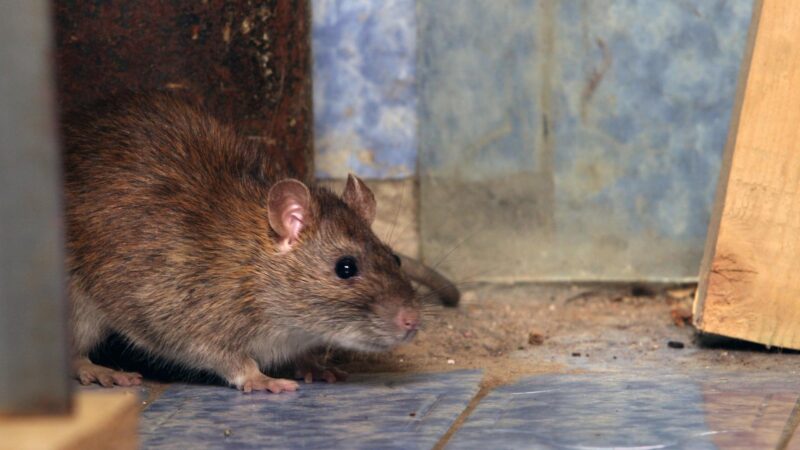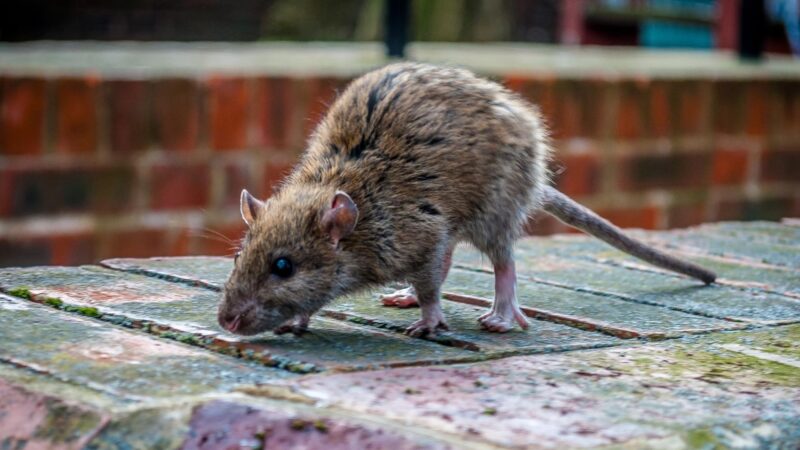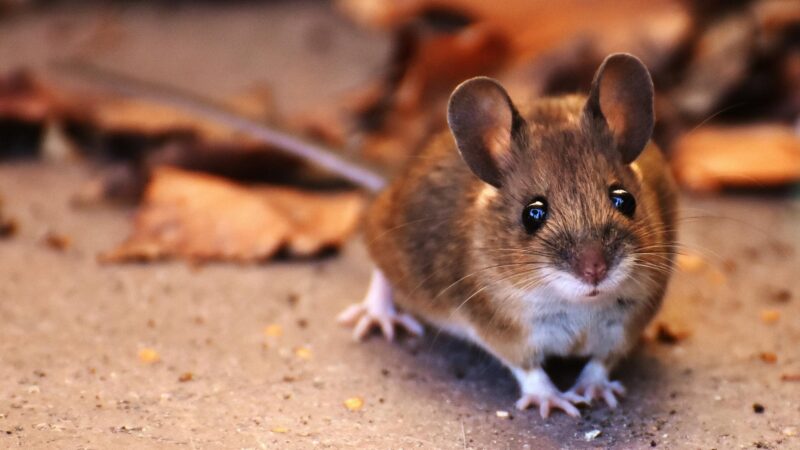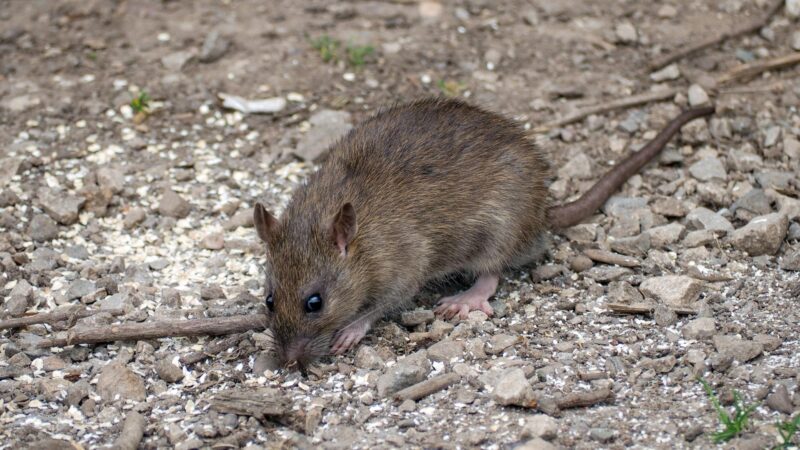As we all know, rats are not only destructive pests; they also contaminate food and transmit serious diseases to humans. Yet, rats are very alert and can easily run away and hide.
This makes them even harder to eliminate. But then, rats are very messy. They always leave some traces on areas where they could be hiding.
How can you tell if you have rats? Some important signs that there is a rat in your house are the following: Rat droppings, rat urine, rat noises, rat rub marks, rat gnaw marks, rat nests, and dead rats in the toilet bowls.
Controlling a rat infestation can be exhausting and expensive. This is why you should get rid of them as early as possible. But before taking any action, you should understand how rats behave inside and outside your house.
This article explains what to look for to identify signs of rats and how to deal with them correctly.
What Are the Signs of a Rat in Your House?

Rats can sense human activities, and they avoid being seen by people. If you look for them, it’s very unlikely that you see all of them at the same time. Rats are not only smart, but they are also very quick in running and hiding.
To make sure of their presence, here are some important signs that there is a rat in your house:
1. Rat Droppings
Rat droppings differ from each other, depending on the species. Droppings from Norway rats look like brown capsules with blunt ends and are about 3/4 inches (19 mm) long.
On the other hand, droppings from roof rats are brown or black, banana-shaped, pointed on one end, and about 1/2 inches (12.7 mm) long.
2. Rat Urine
Rat urine has a very strong ammonia-like smell, just like the urine of other rodents. This unpleasant smell comes from the high amount of nitrogen in rodent urine once it dries.
Rat urine also contains calcium, which leaves a chalk-like residue on the area. This makes the urine smell and stains harder to remove.
3. Rat Noises
Rats create different kinds of distinct noises, depending on the situation. Once there are lots of them, you may hear them hissing at each other and fighting over a small space.
They also squeak when they are in pain and during mating. Rats also make gnawing, running, and climbing sounds, especially after dusk.
4. Rat Rub Marks
As rats travel through small spaces, they are likely to leave some greasy marks on surfaces and walls. They also rub oil and dirt from their fur against pipes and beams.
Since rats are bigger than mice, their smudge marks are much more visible than that of mice. But to view them clearly, you should use a flashlight.
5. Rat Gnaw Marks
Like other rodents, rats have incisors or pairs of upper and lower teeth. Rat teeth are strong and sharp enough to gnaw on wood, plastic, aluminum, copper, and other soft metals.
Rats also need to gnaw from time to time since their teeth grow continually. As expected, rat gnaw marks are bigger than mice gnaw marks.
6. Rat Nests
Rat nests inside a house are usually made of various materials. This includes loft insulation, shredded paper and cardboard, fabric scraps, and other soft materials.
Rat nests are always messy and have droppings and urine around them. If you find a rat nest in your attic, it is likely to have been built by roof rats.
7. Dead Rats in Toilet Bowl
In some cases, you may find a dead rat in your toilet bowl. Rats are excellent swimmers and can hold their breath underwater for about 3 minutes.
During heavy rains, juvenile rats that are in the main sewer system can reach your toilet. But because they are still small, these rats cannot climb the toilet and will drown.
What Attracts Rats To Your House?

Generally speaking, rats are attracted to moisture and all kinds of food sources in your house. This includes fruits, vegetables, seeds, raw meat, food debris, and cooked food.
Rats are also attracted to poorly managed garbage cans, cluttered and seldom-visited rooms, as well as odors of previously rat-infested areas.
Where to Check for Rats Inside Your House?

While inside your house, rats will search for dark and secure areas where they can hide and build a nest. If you want to find them, search your attic, basement, chimney, fireplace, under furniture, and behind the walls.
Since rats love warm environments, they also hide in poorly ventilated areas, especially during winter.
- Lofts & attic spaces – Look for bitten objects, torn lofts insulating material, and rat poop in crevices
- Kitchens & Laundry – Look under kitchen and laundry appliances. In fact, be sure there are no openings where cables or pipework access your house from the outside.
- Out of sight areas – Young rats can fit into tight spaces like crawlspaces, suspended ceilings, and even cavity walls.
Where to Check for Rats Outside Your Property?

If you think there are rats outside your property, they are likely to be hiding underground. In particular, Norway rats dig burrows, usually around the foundation of homes, and use them as nests.
These so-called rat holes usually have one main entrance that is 2-4 inches in diameter and can be up to 18 inches deep.
These rat nests usually have 1 or 2 secret exit holes, which are quite hidden. Norway rats use them in case they need to escape from humans and predators such as cats and snakes.
When active, these holes have smooth walls and pathways. They also release a very strong odor due to rat droppings and urine.
Some of the areas they are hiding are the following:
- Decking – Inspect the decking areas’ margins for evidence of chewing and digging damage. Rats frequently nest under decking in this area.
- Sheds – Check the perimeters of buildings and garages for rat holes. Rats enjoy digging tunnels adjacent to sturdy objects like walls.
- Garages -Look for cracks around the door rails or gaps where the bottoms of wooden doors have been chewed. Inspect the area around the home’s interior entrance and any vents that could allow access if your home has an integral garage.
- Compost bins -Rats love the warmth and food that compost dumps provide. Check composters’ bases and lids for chew marks and holes.
- Vegetation – Look for rat burrows among the roots of trees and shrubs, in unmanaged landscaping, or next to the wasteland.
- Drains – Make sure there are no holes excavated adjacent to the drain covers or if they are broken.
Does One Rat Mean More?
Seeing one rat inside or around your property strongly suggests that there are more of them. This is because rats, in general, are very social creatures. Rats can also be trained, which is why some people keep rats as pets.
A study also suggested that rats show empathy and may help fellow rats who are distressed.
Do Rats Come Out During the Day?
Some rats do come out during the day. Rats are nocturnal mammals, which means that they are most active at night. They also have poor eyesight, but it does not hinder them from traveling during daytime hours.
If you see rats during the day, there could be a lack of food in their area, or their population is already high.
Does Bleach Keep Rats Away?
Bleach keeps rats away because this disinfectant has a chlorine smell that rats cannot tolerate. This is why you can use a bleach solution to drive them away from their nests.
Bleach can also disinfect areas where rats poop and pee. However, exposure to bleach can be harmful to the eyes, skin, and respiratory system.
Do Rats Hate Vinegar?
Rats hate vinegar because of its very strong unpleasant smell. Therefore, white vinegar can be an effective rat repellent. To use white vinegar, soak some cotton balls in it and leave them in their nest or hiding places.
However, the effect on rats is only temporary since the pungent smell will later go away.
What to Do If You Have Signs of Rats?
It is crucial that you get rid of the pests right away if you observe one or more of these symptoms of an infestation. Rodents have the potential to infect people and seriously harm your house.
- Your home’s entryways should be sealed. Mice may enter a house through an opening that is only one-fourth inch wide. Seal off any holes you see on your home’s exterior that mice or rats might be using as entryways.
- For getting rid of rats that are already inside your house, traps are your best chance. Put the traps around your home, away from the reach of youngsters and pets, and bait them using foods like cheese or peanut butter. Check the traps frequently, and get rid of any rodents you catch.
- Remove waste and clutter. In the waste and detritus near your home, rats will build their nests. Attics and basements should be cleaned up, as well as any rubbish mounds that have accumulated there.
What Can You Put Around Your House to Keep Rats Away?
Rats are very intelligent mammals and will do everything to enter your house. Once rats are already inside, you may find it more difficult to get rid of them.
Since rats are seldom seen during the day, it’s better if you prevent them from coming in. Here are some items (and pets) you can put around your house to drive rats away:
1. Cats and Dogs
Cats and dogs are among the natural predators of rats. However, choose the right breed of these pets since some of them don’t chase Norway rats and ignore them.
Also, pet foods that are left outside the house will attract more rats. These rodents may eat them while the dogs and cats are sleeping at night.
2. Snap Traps with Bait
Snap traps such as Tomcat Rat Snap Trap are more humane than sticky traps since the latter won’t kill rats instantly. For the bait, use bacon, dry food, or pet food. If you don’t want to kill rats, use live rat traps, such as Kensizer Humane Rat Trap . But don’t release the rats by yourself. Instead, contact your local animal shelter.
- Reusable trap effectively kills rats and is easy to set by hand...
- Interlocking teeth make escape virtually impossible
- High impact plastic and rust resistant metals allow the rat trap...
- Removable bait cup lets you bait the trap without setting
- Place snap trap perpendicular to a wall or other structure where...
3. Flashing Lights
As mentioned earlier, rats may come out during the day, and they are not afraid of bright lights. On the other hand, a wide variety of different flashing lights can repel rats very effectively.
So, instead of just leaving your outdoor lighting on, use a rodent strobing light device with sound, such as Roxant Pulse Strobe Light.
4. Motion-Sensitive Sprinklers
Rats are afraid of sudden movements, especially when they cannot see clearly. This is why motion-sensitive sprinklers such as Havahart Motion Activated Animal Repellent and Sprinkler can repel rats. Such devices release water automatically once the sensors detect rat body heat and movements within 60 feet.
- Naturally Repels – Repels nuisance animals such as birds, cats,...
- Detects & Deters – The device releases a startling surge of...
- Motion-Activated – An infrared sensor detects animal heat and...
- Multiple Settings – 4 sensitivity settings allow you to adjust...
- Eco-Friendly Design – The motion-activated repellent uses only...
5. Essential Oil Sprays
Cinnamon essential oil, eucalyptus essential oil, and peppermint essential oil are only some of the essential oils that repel rats. Essential oil sprays such as Harris Peppermint Oil Mice & Rodent Repellent Spray can be ideal alternatives for rat traps. But since these oils evaporate quickly, you need to spray repeatedly.
- Plant Based Active Ingredients - Repels mice and rats using plant...
- Long Lasting - Works quickly and offers long lasting protection...
- Safe - The formula can be used throughout a variety of different...
- Pleasant Scent - Although the formula is potent to rodents, the...
- A Smart Alternative - Save yourself the clean up and hassle of...
6. Rat Fence
To prevent rats from entering your property and digging underground, try building a fence around it. Install a 1/4 or 1/2-inch hardware cloth (wire mesh) around your property.
Bury it 12-18 inches below the ground and angle it outwards. Rats may still try to dig outside your property, but they will hit the fence and will retreat.
Related: What Is the Best Way to Exterminate Rats and Mice? | Tips and Guide
List of Sources
Timm, R. M., Salmon, T. P., Marsh, R. E. (2011). Rats. Agriculture and Natural Resources, University of California.
Potter, M. F., Beavers, G. M. Rodents. University of Kentucky.
Rivadeneira, P., Gouge, D. H. (2018). Roof Rats: Identification, Ecology, and Signs. The University of Arizona.
Pierce II, R. A. (2012). Controlling Rats. University of Missouri.
- Bed Bug Surge 2025: How to Detect, Prevent, and Safely Eliminate Infestations in Top U.S. Cities - June 18, 2025
- Asian Needle Ants Invade US Homes: 2025 Guide to Identification, Risks, and Effective Control - June 11, 2025
- New World Screwworm Alert: How US Livestock Owners Can Prevent Outbreaks and Protect Herds [Summer 2025 Update] - June 8, 2025




